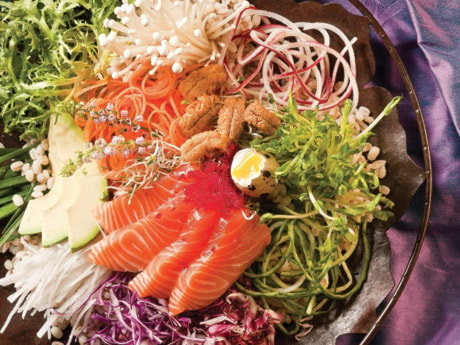Chinese, Japanese and Thai foods have long been popular in Canada, but now it seems that Korean cuisine is the new rising star.
“I think Korean could become the next Thai food craze,” says Alison Fryer, manager of Toronto’s Cookbook Store, a magnet for cooking fans. “There is enough immigration from that country to support it and the food is inexpensive, and if you spent $12 you would have a feast.”
Lucy Waverman agrees. In November, the Toronto-based author, columnist and teacher travelled on a cultural exchange to the G20 meeting held in Seoul, South Korea.
She notes that most Korean restaurants in Canada are “cheap and cheerful places; there aren’t many sophisticated eateries,” but she says that is beginning to change.
Waverman says Korean is a very “specialized food and their barbecue is huge.”
Diners may be treated to a relatively new phenomenon called the pop-up restaurant. These restaurants have caught on in cities such as New York and London and are often opened in eateries that are shuttered for the off-season. They run for a limited time and then close. Knowledge of these rather secretive spaces tends to spread via word of mouth, which adds to their popularity as people clamour to try them.
Fryer says that Scandinavian cuisine is also resonating in the food world.
There is a resurgence of interest in homemade or bakery pies, breads and cookies “and the panini is really big now,” Fryer says.
She notes that over the past two years she has seen a growing interest in acquiring basic home cooking skills among teenagers shopping for cookbooks at the store.
“There has been a general interest in serious cooking and in basic theory,” she says.
For home chefs who want to try their hand at preparing Korean food, The Cookbook Store’s Fryer says the two most popular Korean cookbooks carried at the moment are Dok Suni: Recipes From My Mother’s Korean Kitchen by Jenny Kwak and The Complete Book of Korean Cooking by Young Jin Song.
Sonny Huh, executive chef of the Korean Celadon Restaurant in Whistler, B.C., offers dishes that combine traditional with modern.
“We aim to bridge the gap of Korean tastes with more familiar Canadian fares,” he says.
In the following recipe for Bibimbap Salad, Huh varies a typical Korean dish — a stone bowl of hot rice topped with cooked vegetables and meat — by using ingredients available on the West Coast.
“What I’ve done is take the concept further by combining fresh uncooked garden greens, quail eggs, sea urchin, B.C. sockeye salmon, flying fish roe and barley to evoke the feeling of rice,” he explains.
He then tops it off with his own spicy vinaigrette dressing.
“It’s a refreshing take on the traditional stone bowl version,” he adds.
Bibimbap Salad
500 ml (2 cups) barley rice
1 avocado, sliced in quarters
50 ml (1/4 cup) chicory
50 ml (1/4 cup) julienned carrots
50 ml (1/4 cup) julienned radish
50 ml (1/4 cup) julienned cucumber
50 ml (1/4 cup) julienned red radish
50 ml (1/4 cup) julienned red cabbage
50 ml (1/4 cup) julienned radicchio
8 Shisho flowers
1/2 bundle enoki mushrooms (5 cm/2 inches in length)
50 ml (1/4 cup) alfalfa sprouts, washed and cleaned
50 ml (1/4 cup) bite-size pieces of sockeye salmon
60 ml (4 tbsp) sea urchin
20 ml (4 tsp) flying fish roe
2 quail eggs
15 ml (1 tbsp) salt (to boil quail eggs)
Radish sprouts (5 cm/2 inches) in length), for garnish
Chili Vinaigrette Dressing
125 ml (1/2 cup) Korean chili paste
50 ml (1/4 cup) vinegar (6 per cent to 7 per cent acidity)
50 ml (1/4 cup) sugar
2 cloves garlic, minced
30 ml (2 tbsp) soy sauce
20 ml (4 tsp) roasted sesame seeds (optional)
10 ml (2 tsp) sesame seed oil (optional)
Wash barley rice twice and drain. Place in a pot, add 750 ml (3 cups) water and bring to a boil over high heat. When water is boiling, reduce heat and simmer for 20 to 25 minutes. Mix well and spread on a large plate to cool.
Soak vegetables (except avocado) in ice water for 10 minutes before arranging in serving bowls. They should be crispy in texture.
Place quail eggs in a pot of boiling water with salt for 2 1/2 minutes. Lift out of boiling water and set aside to cool. When cool enough to handle, peel and cut in half. In each of 4 serving bowls, place barley rice. Arrange vegetables, seafood and eggs on top and sprinkle with sesame seeds, if using.
In a small bowl, mix ingredients for chili vinaigrette dressing. Add sesame oil, if using, and swirl on salads just before serving. Garnish with radish sprouts.
